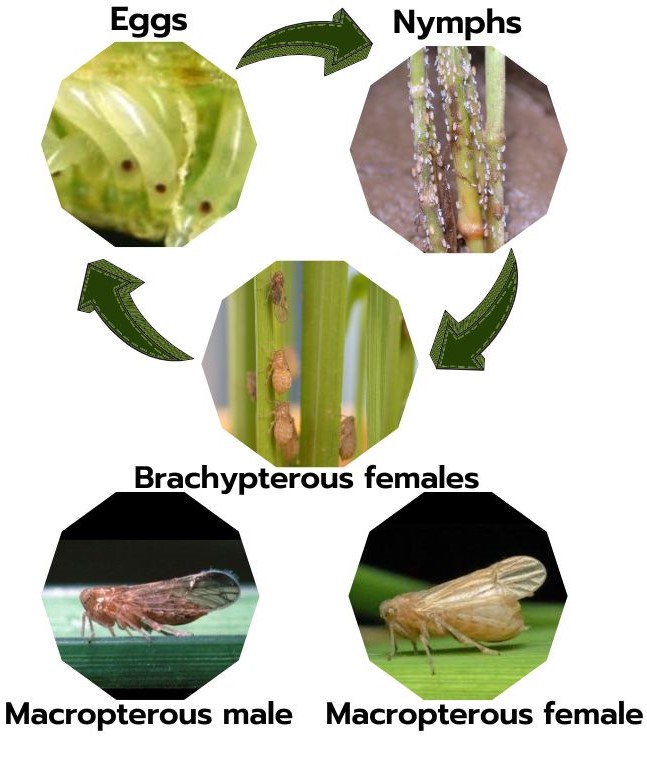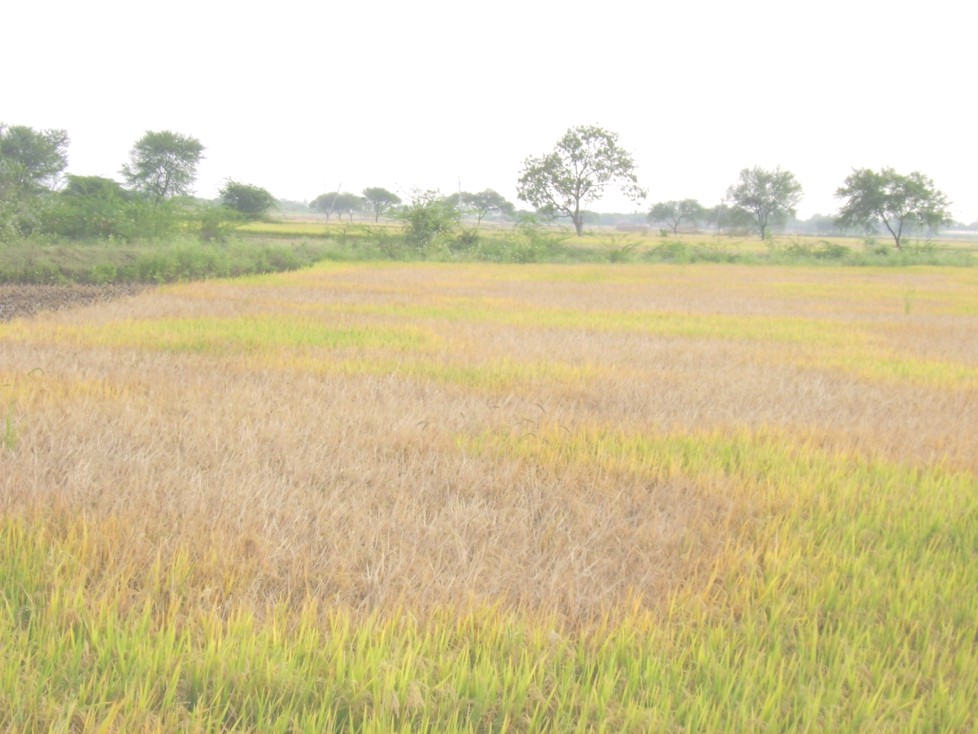
Adult planthoppers are dimorphic. Winged (Macropterous form) as well as half winged males and females (Brachypterous form) along with wingless nymphs occur as mixed populations in fields.
Macropterous forms are the first to appear in the newly planted field and begin colonization. They lay less number of eggs while brachypterous females lay about 300-500 eggs. Eggs are inserted in the tissue of the lower part of the rice plant, mainly near midrib of leaf sheaths and also in leaf blades. The eggs are covered with a dome shaped egg plug secreted by the female. Only the tips of eggs are seen on the plant surface. Eggs are banana-shaped and newly laid eggs are whitish; turn darker when about to hatch. Before hatching, two distinct eye spots appear on the egg. Egg period ranges between 7-11 days. The nymph has triangular head with a narrow vertex. Its body is creamy white with a pale brown tinge.
Nymphal period is generally completed in 12-20 days with five nymphal instars. The nymphal period varies depending on the food conditions, density during development and the prevailing temperature.
Adult BPH has brownish body varying from light brown to dark brown. The adult survives for 10 to 25 days. Thus, total life cycle is completed in 29 - 56 days.

Both adults and nymphs suck the sap from the base of the tillers, resulting in yellowing and drying of the plants. At early stages, round yellow patches appear which soon turn brownish due to drying up of the plants. The patch of infestation spreads in concentric circles within the field and in severe cases the affected field gives a burnt appearance. This condition is known as 'hopper burn' resulting in 100% crop loss. The hopper populations can multiply very fast and migrate over long distances causing widespread infestation in short time. Apart from direct damage, BPH is also a vector of viral diseases viz., grassy stunt, ragged stunt and wilted stunt.
Grow resistant varieties like Cotton dora sannalu (MTU 1010), Vijetha (MTU 1001), Chaitanya (MTU 2067), Krishnaveni (MTU 2077), Surya (BPT 4358), Vajram (MTU 5249), Pratibha (MTU 5293), Deepti (MTU 4870), Godavari (MTU 1032).
Leave alleyways - While planting, for every 2 meters, leave 30 cm alleyway.
Drain stagnant water from the field immediately and allow sunlight and wind to pass through the base of the plants.
Alternate wetting and drying helps in reducing the planthopper population build up.
Rice crop harbours diverse species of natural enemies.
Predators like mirid bugs, spiders and coccinellids that prey on eggs of planthoppers, egg parasitoids like Anagrus, Oligosita species and aquatic predators like Microvelia and Mesovelia help in keeping the planthopper population under check. Hence, conservation of these natueal enemies is very important in rice.
Grow crops like Marigold, Lady's finger, cowpea, pillipesara, Jute, coriander, Sesamum and saunf on rice bunds to provide nectar and pollen for natural enemies to increase their longevity and aid in faster multiplication.
Do not apply synthetic pyrethroids like deltamethrn, cypermethrin, lamda cyhalothrin, either alone or in combination of other insecticides as they cause resurgence of planthoppers.
When there are 10 - 15 BPH/WBPH per plant, spray the following insecticides per acre.
Apply Triflumezopyrim 10.6% SC @ 94 ml/acre between 45 - 60 DAT only once.
In case of severe incidence of planthoppers, apply Pymetrozine 50 WP @ 120 g/acre (or) Dinotefuran 20 WG @ 80 g/acre (or) Acephate 75 WP @ 250 g/acre (or) Glamor 80 WP @ 50 g/acre
Do not repeat or use the same insecticide.
While spraying, nozzle should be directed at the basal portion of the plants.
Application with power sprayer is preferable.